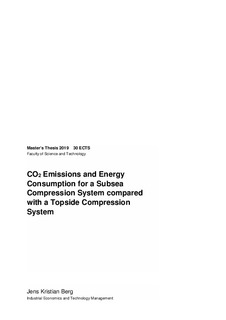| dc.contributor.advisor | Lekang, Odd Ivar | |
| dc.contributor.advisor | Omberg, Ola Sørby | |
| dc.contributor.author | Berg, Jens Kristian | |
| dc.date.accessioned | 2019-07-16T13:15:05Z | |
| dc.date.available | 2019-07-16T13:15:05Z | |
| dc.date.issued | 2019 | |
| dc.identifier.uri | http://hdl.handle.net/11250/2605540 | |
| dc.description.abstract | Increasing the recovery rates of oil and gas fields is a common goal between energy companies and policy makers. Through pressure from the public and policy intervention due to changes in the global climate, there is a push to reduce emissions related to the production of hydrocarbons. The installation of gas compressors is often evaluated for gas fields to better the recovery rate and extend the lifetime when the production rates decline. Through development in technology, offshore compression can in some cases be performed both topside and subsea. This thesis analyses the differences in energy consumption and CO2 emissions for a subsea compression system and a topside compression system targeting increased recovery from a gas and condensate reservoir. Two notional generic gas fields were generated and a realistic production system for both reservoirs was defined. The reservoirs were assigned case numbers 1 and 2, where the difference was the condensate to gas ratio which was specified to be 15 and 1 respectively. Integrated Production Modeling was used to perform predictions of the accumulated production volumes, energy consumption and the associated CO2 emissions. The results show that the total energy consumption and CO2 emissions are significantly lower for the subsea system. The average emissions of CO2 per barrel of oil equivalent produced is approximately 53% lower for the subsea system in both cases. This is because of a lower system pressure drop and accelerated production, causing the total energy consumption of the subsea system to be approximately 37% and 38% lower over the lifecycle for Case 1 and Case 2 respectively. In addition to CO2 emissions from the compression work, emissions from production of construction materials and emissions from the support systems for the topside facility were included in the analysis. The results show that the impact of including the emissions from production of the construction materials is dwarfed by the emissions from direct power usage. The additional emissions from the energy consumption of the topside support systems are a significant contribution to overall emissions over the lifecycle. These make up approximately 23% of the total topside emissions in Case 1 and Case 2. This constitutes approximately 44% and 46% of the difference in total emissions between the two systems in Case 1 and Case 2 respectively. The accumulated production volume was higher for the subsea system in both cases, representing significant additional revenue. The additional production volume is a result of a lower system pressure drop for the subsea system, allowing a further drawdown of the reservoir pressure when compared with the topside system. | nb_NO |
| dc.description.abstract | Å øke utvinningsgraden for olje- og gassfelt er et felles mål mellom energiselskaper og statlige beslutningstakere. Gjennom press både fra det offentlige og fra politiske tiltak som følge av endringer i det globale klimaet, er det et økt fokus på reduksjon av utslipp knyttet til produksjon av hydrokarboner. Installasjon av gasskompressorer blir ofte vurdert for å bedre utvinningsgraden for gassfelt og for å forlenge levetiden når produksjonsratene faller. Etter utvikling av ny teknologi kan offshore gasskompresjon i noen tilfeller nå utføres under vann som et alternativ til konvensjonell kompresjon på en overflatestruktur. Denne oppgaven analyserer forskjellene i energiforbruk og CO2-utslipp for et undervanns kompresjonssystem og et kompresjonssystem montert på en overflatestruktur med et mål om økt utvinning fra et gass- og kondensatreservoar. To generiske gassfelt ble generert, og et realistisk produksjonssystem for disse reservoarene ble deretter definert. Forskjellen mellom reservoarene var mengden kondensat i forhold til gass, som ble spesifisert til henholdsvis 15 og 1. De to reservoarene ble navngitt tilfelle 1 og tilfelle 2. Integrert produksjonsmodellering ble brukt til estimering av akkumulerte produksjonsvolumer, energiforbruk og tilhørende CO2-utslipp. Resultatene viser at det totale energiforbruket og CO2-utslippene er betydelig lavere for havbunnssystemet. De gjennomsnittlige utslippene av CO2 per fat oljeekvivalenter produsert er i begge tilfeller ca. 53% lavere fra undervannssystemet. Dette skyldes et lavere systemtrykkfall og akselerert produksjon, som resulterer i at det totale energiforbruket til undervannssystemet er omtrent 37% og 38% lavere i løpet av livssyklusen for henholdsvis tilfelle 1 og tilfelle 2. I tillegg til CO2-utslipp fra kompresjonsarbeidet ble utslipp fra produksjon av stålmaterialer til systemene og utslipp fra støttesystemene til overflateanlegget tatt med i analysen. Resultatene viser at virkningen av å inkludere utslippene fra produksjonen av stålmaterialene blir forsvinnende liten sammenlignet med utslippene fra det direkte strømforbruket. De ytterligere utslippene fra energiforbruket til overflateanleggets støttesystemer er et betydelig bidrag til de totale utslippene over livssyklusen. De utgjør ca. 23% av de totale utslippene fra overflateanlegget i tilfelle 1 og 2. Dette utgjør omtrent 44% og 46% av forskjellen i totale utslipp mellom de to systemene i henholdsvis tilfelle 1 og tilfelle 2. Det akkumulerte produksjonsvolumet var høyere for havbunnssystemet i begge tilfeller, noe som representer en betydelig tilleggsinntekt. Det ekstra produksjonsvolumet er et resultat av et lavere systemtrykkfall for undervannssystemet, noe som tillater ytterligere reduksjon i reservoartrykket i forhold til overflateanlegget. | nb_NO |
| dc.language.iso | eng | nb_NO |
| dc.publisher | Norwegian University of Life Sciences, Ås | nb_NO |
| dc.rights | Attribution-NonCommercial-NoDerivatives 4.0 Internasjonal | * |
| dc.rights.uri | http://creativecommons.org/licenses/by-nc-nd/4.0/deed.no | * |
| dc.subject | Subsea Boosting | nb_NO |
| dc.title | CO2 emissions and energy consumption for a subsea compression system compared with a topside compression system | nb_NO |
| dc.type | Master thesis | nb_NO |
| dc.subject.nsi | VDP::Technology: 500 | nb_NO |
| dc.description.localcode | M-MPP | nb_NO |

